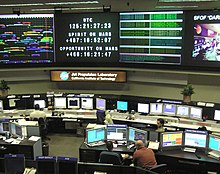Jet Propulsion Laboratory
![]()
JPL is a redirect to this article. For the US automobile manufacturer, see JPL Cyclecar.
34.1994444444-118.174444444Coordinates: 34° 11′ 58″ N, 118° 10′ 28″ W
The Jet Propulsion Laboratory (JPL) builds and controls satellites and space probes for NASA.
JPL is part of the California Institute of Technology (Caltech) at La Cañada Flintridge; under its leadership, NASA's most successful space probe projects have been carried out. To maintain contact with the probes, JPL operates the Deep Space Network. In addition to NASA, JPL works for the United States Department of Defense, the Department of Energy, and other government agencies. It also advises the producers of science fiction films and series (such as Babylon 5).
The JPL is now located on a 72-acre site in La Cañada Flintridge, California, though the official address is 4800 Oak Grove Drive, Pasadena, CA 91109. There are approximately 5500 full-time employees working at the JPL, and several thousand other people employed by service providers. In 2003, the budget was nearly $1.4 billion.

A control room of the JPL

Overview of the JPL complex

JPL sign
History
JPL was created in the 1930s when Caltech professor Theodore von Kármán, along with students and assistants, began conducting experiments with rocket engines. On October 31, 1936, they launched their first rocket.
Von Kármán convinced the US Army to support him. The Army asked the newly assembled team to study the German V2 rocket, using the name Jet Propulsion Laboratory for the first time. This name was given to the research facility in order to create a serious impression to the outside world, since at that time dealing with rockets was considered frivolous.
Based on the research results of JPL, the Corporal rocket was developed, which the Americans put into service from 1955 and stationed in Europe. On December 3, 1958, NASA, founded two months earlier, took over JPL from the military. Unlike the other centers, JPL is not part of NASA, but only affiliated with NASA. JPL is part of the University of Caltech.
JPL kept its name, although in the following period no more research on jet propulsion (rockets) was carried out. Instead, it developed into the world's leading center for space probes, their technology and planetary research. However, JPL has recently faced serious competition from the Applied Physics Laboratory at Johns Hopkins University.
Space Exploration
On January 31, 1958, JPL launched Explorer 1, the first U.S. satellite. In the 1960s, JPL launched the first space probes to the moon (Ranger) and missions to other planets (Mariner). On December 14, 1962, Mariner 2 became the first spacecraft to fly past a foreign planet (Venus). In 1976, the Viking probes searched for life on Mars for the first time. In 1977 Voyager 1 and Voyager 2 were launched to the outer planets. In October 1998, Deep Space 1, a space probe with ion propulsion and other new technologies, was launched.
The cneos at JPL publishes the Sentry Risk Table, which regularly maps the latest research results from the Sentry monitoring system on the impact risk of Earth orbit cruisers.
Furthermore, JPL developed the so-called JPL sequences. These are special code sequences which are used, among other things, in space applications for distance measurement and can shorten the synchronization times for spread spectrum signals. Furthermore, JPL sequences are used in the global positioning system (GPS) for the transmission of the P/Y code used in military applications.
Earth Explorer
In the 1970s, JPL showed that instruments aboard space probes could also be used to study Earth, resulting in the Seasat mission.
Missions
JPL's missions include:
- Explorer 1 to 5
- Mariner 1 to 10
- Ranger 1 to 9, Surveyor 1 to 7
- Seasat
- Viking 1 and 2
- Voyager 1 and Voyager2
- Galileo
- Magellan
- The Mars rovers Pathfinder, Opportunity and Spirit
- Cassini
- Mars Science Laboratory
- Dawn
- InSight
- Mars 2020
JPL also built instruments for other projects, such as the Hubble Space Telescope's wide-angle camera, and tests new technologies for NASA, such as the Low-Density Supersonic Decelerator.
Search within the encyclopedia